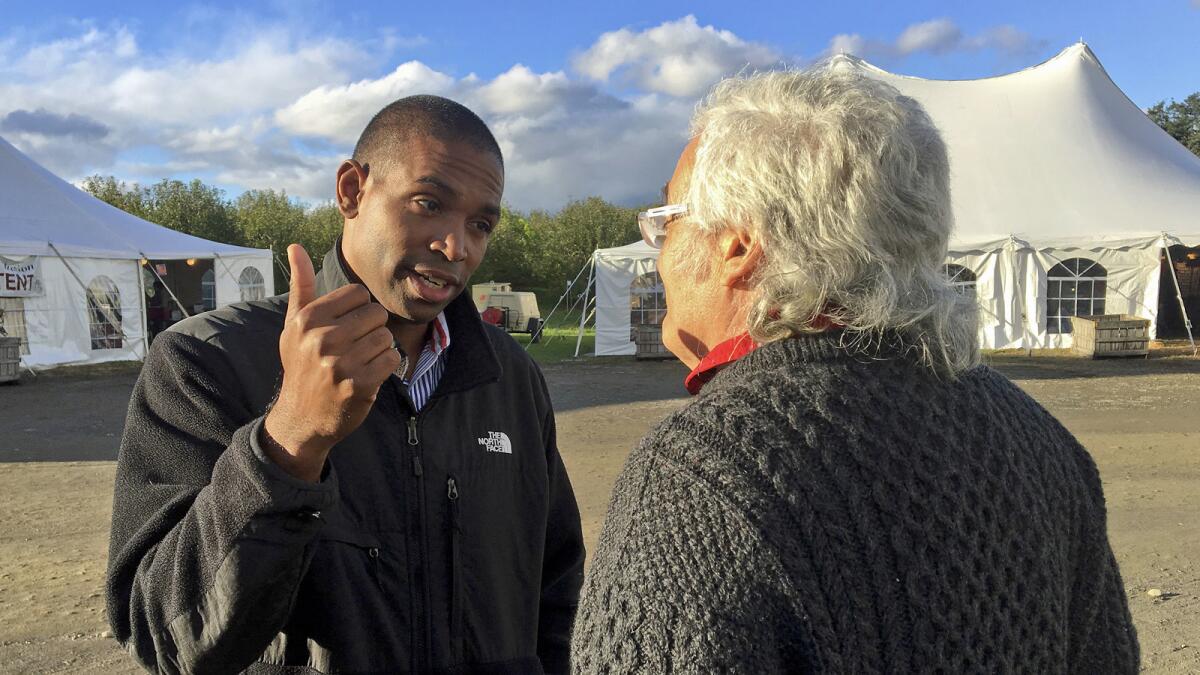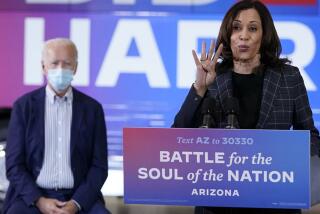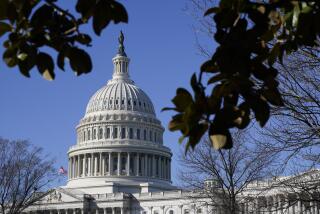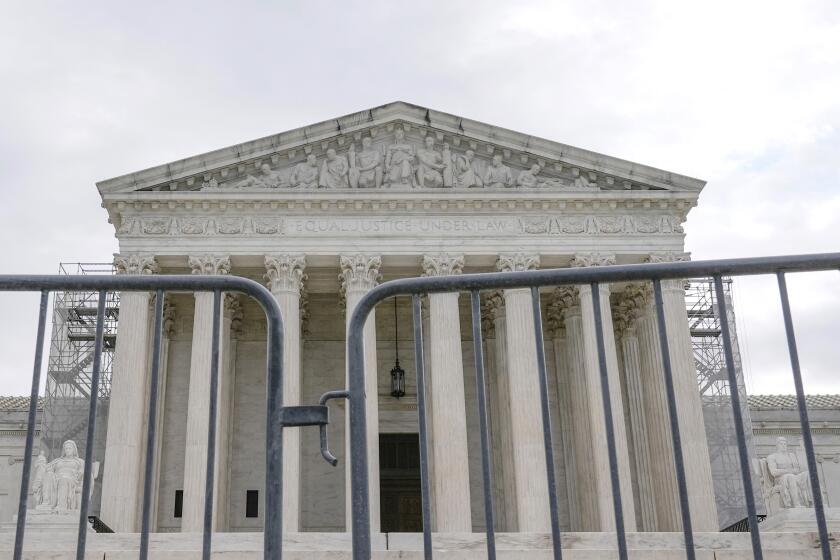Election night viewers guide: 25 races to watch

Across the country, voters will decide thousands of contests this election day. Keeping track of them all would daunt even the most devoted political junkie. Here’s an assortment of some of the most interesting or consequential contests.
Toss-up races that could decide control of the Senate
A dozen Senate races have been competitive to some extent this year. These five remain the closest and likely will determine which party controls the Senate for the next two years.
Republicans currently have a 51-49 majority. They’re favored to keep control and, perhaps, expand their margin a bit. That would allow the Republicans to continue confirming President Trump’s judicial nominees, among other acts.
Arizona and Nevada give the Democrats their best hopes of picking up Republican seats. Missouri, Indiana and Florida feature the three most endangered Senate Democrats.
ARIZONA: Rep. Kyrsten Sinema (D) vs. Rep. Martha McSally (R)
Republican Sen. Jeff Flake — an on-again, off-again Trump critic — decided to quit rather than likely lose a GOP primary. To replace him, voters have a choice between two candidates who’ve undergone political makeovers. McSally forged a reputation for relative moderation as a member of Congress from the Tucson area. She has declined to say whether she voted for Trump in 2016. But to win the nomination, McSally became an all-in Trump acolyte. Sinema shed her past as a Green Party liberal after being elected to represent the Tempe area in 2012. She’s positioned herself now as a nonpartisan problem-solver. The race will test Democrats’ hopes that a growing Latino population will move Arizona into their column.
NEVADA: Jacky Rosen (D) vs. Sen. Dean Heller (R)
Nevada has trended Democratic in presidential races but has remained Republican in most off-year elections, when voting falls off dramatically. Heller, the only Republican senator running in a state Hillary Clinton carried in 2016, managed to alienate all sides by publicly flip-flopping on repeal of the Affordable Care Act. But his chilly relations with Trump have since thawed.
Rosen is a computer programmer and former head of her synagogue in Henderson, Nev. Heller has made an issue of her thin political resume. She has pointed to his close ties to Trump and his votes on healthcare.
The key question will be whether the Democrats can run up a big enough margin in Clark County (Las Vegas) to offset Republican margins elsewhere.
MISSOURI: Sen. Claire McCaskill (D) vs. Josh Hawley (R)
In 2012, McCaskill got reelected in large part by intervening in the Republican primary to help the candidate she thought she could most easily beat, Rep. Todd Akin. Not long after winning the primary, Akin proved her right, declaring that in cases of “legitimate rape,” women don’t become pregnant because “the female body has ways to try to shut that whole thing down.” The race pretty much ended there. This year, McCaskill faces a more legitimate opponent, the state attorney general, who many Republicans see as a rising star. Republicans have attacked her as out of touch with an increasingly conservative state. She’s fought back by pointing to Hawley’s decision to join other Republican state attorneys general in suing to overturn the Affordable Care Act’s protections for people with preexisting health conditions.
INDIANA: Sen. Joe Donnelly (D) vs. Mike Braun (R)
Donnelly’s campaign illustrates the difficulty of running as a Democrat in a conservative state: He has touted his record of voting with President Trump on several issues, but also his support for the Affordable Care Act. Braun, a businessman and former state legislator, has run as a political outsider and accused Donnelly of lacking convictions. But Donnelly’s efforts to steer down the middle may be just successful enough to get him another term.
FLORIDA: Sen. Bill Nelson (D) vs. Gov. Rick Scott (R)
Since the presidential election of 2000, Florida has produced some of the nation’s closest elections. Also since 2000, Republicans have repeatedly targeted Nelson, a bland, low-profile lawmaker who nonetheless has won repeated statewide races. Scott, a wealthy former healthcare executive, spent more than $100 million in his two successful races for governor, and this race could break spending records. Democrats hope Nelson will benefit from a high turnout spurred by their candidate for governor, Andrew Gillum.
Some bellwether congressional races
Several dozen races around the country have come down to the wire too close to predict. These should provide good, early tests of which side is coming out on top. Nearly all the toss-up races involve seats currently held by Republicans. The exception is Minnesota’s 1st district, in the state’s southeastern corner, where the Democratic incumbent decided to run for governor rather than try for reelection.
Affluent suburban districts: Democrats hope to make gains in suburban areas with large numbers of college-educated voters, many of whom have been alienated by Trump. These races will provide good tests of how that strategy is working.
NJ 7 — Rep. Leonard Lance vs. Tom Malinowski
The district includes Trump’s golf club in Bedminster, where he spends many weekends, but voters here narrowly backed Hillary Clinton for president in 2016. Lance voted against two of his party’s biggest legislative efforts, the tax bill and the repeal of the Affordable Care Act, but that may not be enough against an opponent running as a moderate who worked with former Sen. John McCain (R-Ariz.) to end torture. This race will be a good early indicator of just how large the pure force of Democratic enthusiasm may be this cycle.
NJ 3 — Rep. Tom MacArthur vs. Andy Kim
Democrats have their eye on four of five Republican-held seats in New Jersey, relying on anger at the GOP’s signature tax law passed last year, and the loss of a tax credit disproportionately used by people in wealthy states. MacArthur was the only New Jersey representative to vote for the tax law, making him a particular target of Democrats. A Democratic win here could signal how the tax bill might play in other wealthy areas represented by Republicans, including Orange County, that felt the loss of the deduction for state and local income taxes.
VA 7 – Rep. Dave Brat vs. Abigail Spanberger
Brat won this seat from House Majority Leader Eric Cantor in the 2014 primary by running to his right on immigration. This district is more conservative than the two in New Jersey. If Spanberger wins, it could be a strong harbinger of a Democratic night. Spanberger, a former undercover CIA operative, benefits from enthusiasm for Democratic Sen. Tim Kaine at the top of the ticket, polls show.
TX 7 — Rep. John Culberson vs. Lizzie Fletcher
Culberson is a member of the tea party and hasn’t had a tough race since 2008. Clinton carried this Houston area district in 2016, and Democrats have focused heavily on the incumbent’s vote to repeal the Affordable Care Act. If this district flips to Democrats it will indicate that Democratic gains in the suburbs will extend beyond coastal states.
CO-6 — Rep. Mike Coffman vs. Jason Crow
Coffman’s suburban Denver district has been a Democratic target for years, and he knows how to run a tough campaign and when to break with his party, but he could be swept out in a strong Democratic tide. National Republican groups pulled their money from the contest when they began to triage races in September. Crow has focused on tethering Coffman to Trump in an increasingly blue state.

More blue-collar districts: If Democrats can win in some of these districts, their gains in the House could outstrip expectations.
KY 6 – Rep. Andy Barr vs. Amy McGrath
Trump won this district by 15 points in 2016, and the president held a campaign rally for Barr in mid-October, so if Democrats turn out in droves and win here it could be an early test of how incumbents who have embraced Trump fare. McGrath, a former Marine fighter pilot, also represents the wave of Democratic veterans, including several women, that Republicans have struggled to fend off this cycle.
NY 19 — Rep. John Faso vs. Antonio Delgado
Faso was an immediate target for Democrats after winning his first term in 2016. Trump carried this district in the Hudson Valley by six points, but Faso has tried to distance himself from the president in recent months. Democrats have consistently hit Faso for his 2017 vote on the GOP healthcare bill. The Republicans have run television ads that focus on rap songs that Delgado, who is African American, wrote when he was younger. The Democrats have called those ads racist.
A district Democrats may lose
MN 1 — Jim Hagedorn vs. Dan Feehan
This rural Minnesota seat is currently held by Democrat Tim Waltz, who is running for governor. It went for Trump and is one of the few districts in the country where Democrats are playing defense. This is Hagedorn’s third bid for the seat.
Five closely contested races for governor
Republicans hold most of the nation’s governorships, so they’re playing defense this year. Democrats expect to win several big-state races, especially across the Midwest in some of the states that played major roles in Trump’s victory in 2016. These five are among the closest contests — all in states that currently have Republican governors.
Florida — Andrew Gillum (D) vs. Ron DeSantis (R)
Perhaps no race better captures the political moment than this one. Not only does the country’s most important swing state serve as the backdrop, the campaign pits a progressive Democrat against a Trumpy Republican. The governor’s office is being vacated by Rick Scott, a Republican running for a U.S. Senate seat. Gillum would be Florida’s first black governor; DeSantis recently stepped down from his congressional seat to focus on the race.
Georgia — Stacey Abrams (D) vs. Brian Kemp (R)
This campaign has received close scrutiny for its potential to make history and for controversial efforts by Republicans to limit who can cast ballots. Abrams, a former state lawmaker, would be the first elected black female governor in the country if she wins. Democrats accuse Kemp, Georgia’s secretary of state, of blocking more than 50,000 voter registrations, mostly from minority residents. The case has generated a court battle as the election approaches. Kemp has denied that he’s trying to suppress voter turnout. Georgia law requires a runoff if no candidate gets 50% of the vote, and with minor parties on the ballot, this race could head to overtime.
Ohio — Richard Cordray (D) vs. Mike DeWine (R)
Cordray rose to prominence as the first director of the Consumer Financial Protection Bureau, which was created under President Obama in the wake of the financial crisis. DeWine is the state’s attorney general. Ohio is a longtime swing state, that went heavily for Trump in 2016. This year, Democrats hope they may be able to swing it back, in part by using consumer protection issues and criticisms of big banks to recapture some of the populist energy that Trump profited from.
Wisconsin — Gov. Scott Walker (R) vs. Tony Evers (D)
Walker became a national conservative hero for battling unions and fending off a recall effort six years ago. But he’s encountering stiff headwinds as he seeks a third term in office. Evers, the state schools superintendent, has made Wisconsin’s sagging education system a focal point of his campaign. This is one of several races around the country being watched for evidence of teachers’ newfound political activism. Wisconsin played a key role in Trump’s victory, so a Democratic win here would also indicate that the Republican wave in the Midwest has started to reverse.
Kansas — Laura Kelly (D) vs. Kris Kobach (R)
A Republican stronghold, Kansas was ground zero for Gov. Sam Brownback’s experiment with slashing taxes to spur the state’s economy. The plan hasn’t generated the promised growth, leading to years of budget crises. That’s presented an opening for the Democrats. Kelly, a state senator, has drawn even in polls with Kobach, the state’s secretary of state, who is best known nationally for conjuring a nationwide specter of voter fraud.
Democrats could win back control of several state legislatures
Republicans currently have so-called trifectas — control of the governorship and both houses of the state legislature — in 26 states. Democrats have eight. Democrats hope to overturn several of the Republican trifectas and pick up a few of their own this year, giving them a stronger voice in policy decisions and in the redistricting that will come after the 2020 census. These four are among the most likely to flip.
COLORADO: Democrats have spent heavily to flip the state Senate to blue. Republicans currently have a two-seat majority. Democrats already control the state House and are favored to win the race for governor, so winning the Senate would give them a trifecta in a state that seems to be moving from purple to blue.
MINNESOTA: Both chambers are in play in a test of how much damage the Republicans may suffer this year in suburban areas. The state Senate is currently evenly split, and a special election in a Republican-leaning district will decide which party gets a majority. In the House, Republicans currently have a majority, but are defending 15 suburban districts in which Democrats hope that a backlash against Trump will bring them a majority. The Democrats are also favored to keep the state’s governorship.
NEW YORK: For years, gerrymandered districts and support from some renegade Democrats has allowed Republicans to keep control of the state Senate even as Democrats dominate statewide elections and the state Assembly. This year, that last Republican hold on power could disappear, giving Democrats full control of the state government.
WISCONSIN: Republicans currently control both houses of the Legislature and the governorship. In addition to the governor’s race, they could lose control of the state Senate, bringing a dramatic turnabout for a state that has been a laboratory for conservative, Republican policies for the last eight years.

Ballot measures on voting rights, global warming and healthcare
Voters will decide on a host of policy issues in state ballot measures. Here are a few of the most significant.
Voting rights: Florida’s Amendment 4 would automatically restore the right to vote for people convicted of most felonies after they have completed their sentences. The state currently has one of the most restrictive laws in the country regarding voting by ex-felons. The measure would restore the right to vote to an estimated 1.5 million people. Polls have shown it with strong support, but it requires 60% of the vote to pass.
Carbon tax: The state of Washington could become the first state in the country to tax carbon as a way to combat global warming. The state’s Initiative 1631 would impose a $15 fee on each metric ton of carbon emitted. The fee would rise $2 a year until the state hits its 2035 emissions target. A state analysis estimates it would generate $2.3 billion over five years that would be spent on clean energy and air quality improvements. Oil companies have spent more than $30 million to oppose the measure, outspending environmental groups and other backers. Currently, California is the only state to put a price on carbon, which it does through a system of tradable emission permits, rather than by a tax.
Medicaid expansion: Voters in Idaho, Utah and Nebraska will decide whether to expand Medicaid coverage in their states under the Affordable Care Act. Montana is also holding a referendum on Medicaid, but it differs from the other three because it would extend a Medicaid expansion that is already in place. Under the law, states can expand Medicaid to cover adults with incomes up to 138% of the federal poverty level, with the federal government picking up nearly the full cost. So far 33 states and the District of Columbia have done so. Republican legislators in the remaining states have blocked expansion, arguing that it costs too much. In these Republican-majority states, voters will decide whether to bypass the legislature.
Automatic voter registration: Michigan and Nevada will vote on measures (Proposal 3 in Michigan, Question 5 in Nevada) that would automatically register citizens to vote when they receive a driver’s license or state ID card. People could opt out of registration if they choose to. Supporters call automatic registration a major step toward getting more people to vote.
Get the latest news from the nation’s capital on Essential Washington >> »
For more on Politics and Policy, follow me @DavidLauter
More to Read
Get the L.A. Times Politics newsletter
Deeply reported insights into legislation, politics and policy from Sacramento, Washington and beyond. In your inbox three times per week.
You may occasionally receive promotional content from the Los Angeles Times.






